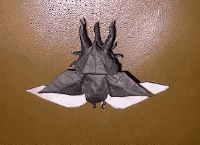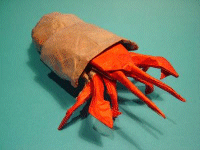




|
Insects and Supercomplex Origami
This is a small collection on some of the more difficult creations that I have come up with. It is recommended that only the expert attempts these models as they involved lots of tricky folds. Insects are a challenge to design due to the number of legs, wings and body parts. As a result, a series of special bases need to be devised.

|
Chalcosoma caucasus, popularly known as the "Atlas beetle", is one of the largest insects on Earth. Males often measure up to an impressive 120 mm (4.75 inches) in length, and have three enormous horns, used for fighting other males when competing for mating.
|

|
The praying mantis is a well recognised insect, with rather distinct hunting and mating styles. The crease pattern provided the base for this model. You will need to repeatedly sink the sides to thin down the model (sixths or eights), and will need to use rather forgiving paper, too.
|

|
The hermit crab is a crustacean rather than an insect. However, this model has lots of thin points, and uses a similar base to many insects. I have provided the base for the model. A lot of box-pleating is required to narrow the points, as well as wrapping the final layer of each pleat around to create a colour change. Enough paper needs to be freed in on of the flaps to create the claws - this becomes easier once the colour-change wrap has been made.
|
|



















